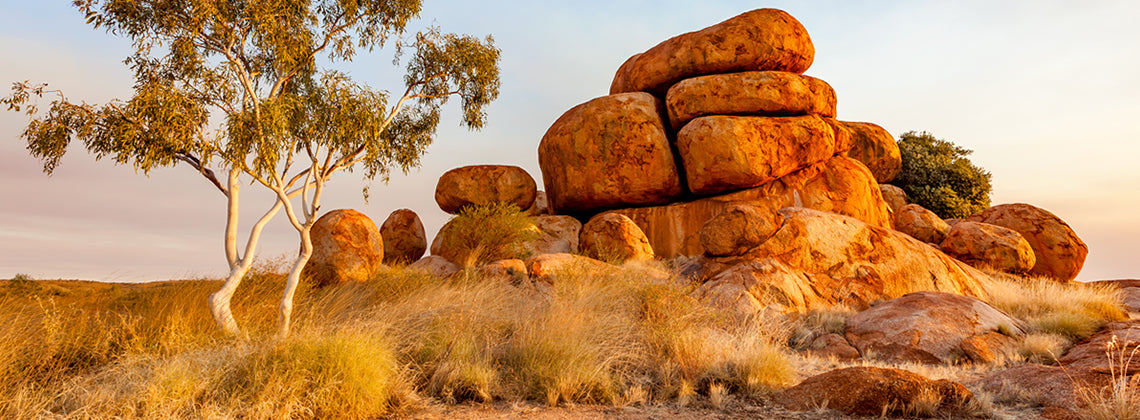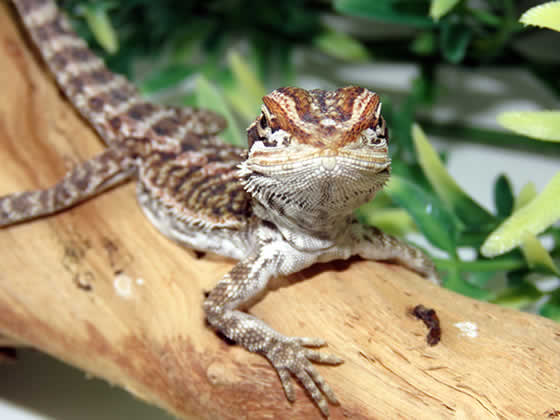Free Delivery
On order over £99*
The name bearded dragon can relate to a number of species of agamid lizards but most commonly in the UK, and the one this care sheet will predominantly refer to is the 'Central bearded dragon' (Pogona vitticeps). Other species include the 'Eastern bearded dragon' Pogona barbata, the 'Kimberley bearded dragon' Pogona microlepidota, the 'Western bearded dragon' Pogona minor, the 'Nullabor bearded dragon' Pogona nullarbor, and technically the 'Rankin's dragon' Pogona henrylawsonii though we have a seperate care sheet for that species here.
Central bearded dragons are naturally found throughout the hot outback desert of Australia. Often seen climbing upon rocky outcrops or fallen trees, bearded dragons love basking in the Australian sun. However, they will usually retreat into a burrow during the hottest part of the day.
The natural bearded dragon habitat most commonly consists of compacted sandy clay with scrubland plants, succulents and cacti.


Bearded dragons come from a very warm environment so they struggle with the colder climate in the UK and require heating and lighting to thrive. To insulate against the cold and help keep temperatures consistent we recommend keeping a bearded dragon in a wooden vivarium. Due to the temperature gradient required for this species we recommend an enclosure as close to 4 x 2 x 2ft (width x depth x height) as possible.
When selecting the vivarium, we look for an enclosure with numerous large vents and glass sliding front doors. All of this ventilation should ensure that heat is lost from one side of the enclosure to the other while keeping the basking spot itself at a consistent temperature.
Younger dragons may feel exposed and frightened in large open spaces so we make sure to include a lot of decorations. These can be removed as the dragon grows in size and gets used to its environment, providing more space to move around and bask within the enclosure.
Naturally, bearded dragons spend a long time basking in the full heat of the sun. As such they require a very warm basking area of 38℃ to 43℃ (100℉ to 110℉) during the day. We try to provide this heat over 1/3 of the enclosure while letting the enclosure cool to 27℃ (80℉) on the opposite side. To achieve this we attach a strong basking lamp to the ceiling of the enclosure on one side. This is controlled by a dimming thermostat to make sure that the temperature is kept correct throughout the day. The basking lamp is left on for 10-12 hours per day.
At night, all of the lights should go off and the enclosure should be completely dark. This will make sure that the dragon has a clear day and night cycle.
During the night time the enclosure should get cooler but we still provide some warmth throughout the night. We aim for a temperature gradient of 27℃ (80℉) on the hot end down to room temperature on the other side. To provide this warmth throughout the night without introducing light to the enclosure we attach a ceramic lamp to the ceiling in the back corner of the warm end of the enclosure. This lamp is surrounded by a guard and controlled by a pulse thermostat to make sure that it stays at the correct temperature throughout the night. Ideally, we would like 1/3 of the enclosure to remain warm allowing the rest of the enclosure to drop down to room temperature.
If you would like the heating and lighting to run automatically you could use a mechanical timer with your UVB tube and basking lamp. As the ceramic heater is set to a much lower temperature than the basking lamp it can be left on all of the time. Your thermostat will only provide power to the ceramic heater when the enclosure drops below the set temperature (27℃ / 80℉). By leaving the ceramic on and controlled by a thermostat you are also introducing a redundancy. If the basking bulb were to blow while you are away from the enclosure, the ceramic heater would take over and keep the enclosure warm until you could intervene.
Though the thermostats we sell are very reliable it is always best practise to monitor your temperatures with a thermometer. A 2℃ (5℉) variance on the basking spot is nothing to worry about as long as your cool side is still cool. A simple dial thermometer on each side should be sufficient but digital probe thermometers are much more accurate.


As described in the previous section, a wild bearded dragon will spend a lot of its time basking. During this period, the dragon is exposing itself to plenty of warmth and UVB. This species will bask for a long time during the day but won't be out for quite as long at noon when the heat and UVB is at its strongest.
To aid in deciding which intensity UVB is required for each species, UVI readings have been taken in their natural habitat. These readings are compiled over time to get an average exposure reading which sits in one of 4 distinct ranges called Ferguson zones. Zone 1 animals get very little UVB exposure, Ferguson Zone 2 consists of partial baskers, zone 3 are basking reptiles and zone 4 animals bask in UVB intense environments. Bearded dragons are recorded as basking in Ferguson zone 3 (UVI 1.0-2.6).
In the same way we allow a little variance in the temperature of the basking spot we would not worry too much if the UV exposure is a little too strong at the closest point. As long as there is a gradient present the bearded dragon will place itself in the perfect position.
UV tubes are currently available in 2 sizes, T8 and T5. The T8 lamps are around 1 inch in diameter, they must be replaced every 6 months or so and they have an effective range of 9-12 inches. T5 lamps are the newer iteration. They are around half an inch in diameter, they must be replaced every 12 months and have an effective range of 18-24 inches.
If the enclosure is 2ft tall as recommended we would advise using a T5 unit and for this species a Zone 3, 10% or 12% UVB tube. When mounted around 30cm from the main basking spot these UVB tubes should provide the correct basking zone. The UVB unit should be mounted to the ceiling close to the back wall. This configuration will provide a nice UV gradient from the back of the enclosure towards the front and from the top of the enclosure to the bottom. With the UV and basking lamp set up this way we achieve a temperature gradient along the width of the enclosure and a UV gradient along the depth of the enclosure. This means that whatever the dragon's requirements they can find the perfect position within the enclosure.
Though the bearded dragon is a basking species it may desire some time during the day in an area with little to no light. To allow this we advise providing partial and full hiding spots throughout the enclosure.
Bearded dragons thrive in a low humidity environment with hard decorations to climb over and bask on. When selecting a bedding we try to ensure that the pieces are unlikely to stick to the dragon's food, and are not going to increase the enclosures humidity. In store we normally use a coarse beech woodchip as it is clean, cheap and easy to spot clean. If you prefer a more natural looking bedding a sand / soil / clay mix would be perfect. If you plan to keep the dragon in a bio-active enclosure a nutrient rich soil and clay mix with some sand for aeration would be best.
Though the dragon has a temperature gradient running from side to side which we will be keeping at the correct temperatures, there are times when the dragon will want to get really hot. To allow this we use dry hard wood decorations like java wood or grapevine pieces situated near the warm end but far enough from the lamps that the dragon is not at risk of coming into contact with the basking lamp. The dragon will climb its decoration to get to a hotter part of the enclosure.
Bearded dragons love the warmth coming from their basking lamp but they also appreciate secondary belly heat which will radiate from warm objects. Natural rocks like slate are perfect for this, so are heavy artificial ornaments. These decorations can be placed under and around the basking area and should warm up nicely. If the lamp is too low there is a chance that natural rocks could get too hot so you are best to check the surface temperature to avoid burns.
As discussed in the lighting section there will be times when the dragon does not want any UV and needs a bit of shade. To ensure that the dragon can get away from the light whenever necessary we advise spreading full and partial cover throughout the enclosure. Examples of full cover decorations would be caves, flat cork pieces or any other ornament that provides a shady spot to rest. Examples of partial cover would include tall plants, trailing plants and themed ornaments like skulls or a cactus skeleton.
Bearded dragons are omnivorous meaning that they will eat a varied diet of vegetables and insects. Though they may try to eat meat and fruit these can cause stomach upset and are not an essential part of the dragon's diet so we would advise you avoid them. Similarly, there are vegetables and live foods that can be fed to the dragon but are not particularly nutritious and should not be used as a part of the main diet.
For the carnivorous part of this omnivorous diet, we would recommend brown crickets. They are very nutritious, fairly easy for the dragon to hunt, widely available and great value for money. If your dragon will not take them, black crickets and locust are also a brilliant alternative. Every now and again you might want to provide your dragon a treat, for this purpose you could feed: waxworms, calciworms, cockroaches, mealworms or beetle grubs. The grubs and worms tend to be quite fatty so we normally offer these a maximum of once or twice a week. Mealworms, morio worms and cockroaches can be difficult to digest so we would normally only provide these to mature dragons (18 months or older) and only once or twice a week.
For the vegetable portion of the diet, we recommend spring greens, curly kale and Italian herb mix as the base of the salad. Grated carrot, parsnip or courgette can be added for additional textures and chopped bell peppers can be added to provide colour to the salad and make it more enticing for the dragon. Vegetables to avoid include onion, peas, spinach, iceberg lettuce and anything else that might be acidic or could swell with moisture. A few times a week it is advised that some roughage is added to the salad. Various weeds or plants like plantain, dandelion, chick weed can be chopped up and added to the top of the salad. Alternatively dry herb cobs or flower mixes can be rehydrated and mixed into the salad.
We always include a medium or large sized water bowl in the dragon's enclosure. You might never see the dragon drink from it but it should be there as a back-up. You might notice the dragon use it for bathing, this is usually to cool down or to help loosen its shedding skin. Both the food dish and water bowl should be kept on the cool side of the enclosure to prevent them from raising the humidity in the enclosure.
Bearded dragons will get most of what they need from their diet but there are some vitamins and minerals that they require in higher concentrations. These are normally provided in the form of calcium and vitamin powders which are dusted onto the live food and sprinkled onto the salad.
There are many brands and types of supplement but normally they come down to a pure calcium, calcium and vitamin or vitamin only supplement. Within these groups they will also either include or exclude synthetic vitamin D3. Vitamin D3 is produced by the reptile when it is exposed to UVB and among other functions it allows the dragon to use the calcium in their diet. If you are sure that the UVB levels in your enclosure are perfect you can use a supplement without D3, if you are nor sure it would be best to use a supplement with some D3.
In our store we currently use a simple calcium powder with D3 and a balanced multi-vitamin with D3 called nutrobal. For most of the animals we alternate these daily so that they get their vitamins every other day while getting calcium every day.
If you keep a male and female together, they may breed. You do not need to do anything to encourage this. As long as they are healthy and the conditions are good, it will happen naturally. You need to consider whether you want this to happen before introducing the pair. What will you do with the babies if you incubate the eggs?
A gravid female should have access to a nesting box to lay her eggs. The box should be large enough that she can fully turn-around inside it. Inside the nesting box we use a soil mix that is kept humid enough to hold its shape but not so wet that it will saturate any eggs. We have found that ProRep spider life is perfect for this.
Once laid, the eggs should be incubated in an incubator at 29℃ (84℉). We incubate our eggs in sealed boxes on a moisture rich substrate (such as Hatchrite) to trap the humidity around the eggs. After approximately 60 days the eggs will start to hatch, the first babies to emerge will encourage the rest of the eggs to hatch.
Bearded dragons, as with most pets, require a clean environment to thrive. We recommend a spot clean as often as possible (every day) and a full clean every 4 weeks or so. If you are keeping the dragon in a bio-active enclosure you can spot clean and monitor the enclosure. It may still be a good idea to change out the bedding a few times per year.
When cleaning the enclosure, you should remove your animal, all decorations and all of the bedding. Once the enclosure is clear you can spray it all over with a reptile friendly disinfectant. These usually work very quickly and only need to be left for around 30 seconds, instructions can normally be found on the disinfectants packaging. Once the disinfectant has done its work it can be wiped away from the surfaces with a paper towel. In some cases, you might want to repeat this process a second time to ensure that the enclosure is thoroughly cleaned.
Your decorations can be cleaned in a similar method, simply spray them down with the disinfectant and rinse thoroughly with water before drying them off and putting them back into the enclosure. We recommend this process is done during the day time to make sure that the dragon will be going back to a warm vivarium for at least an hour before the basking lamps are turned off for the night.